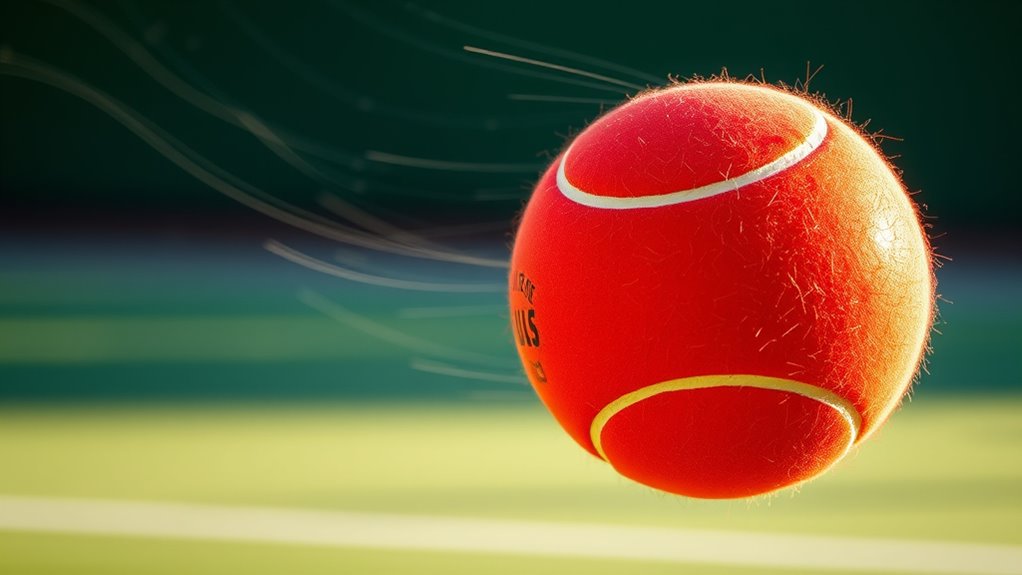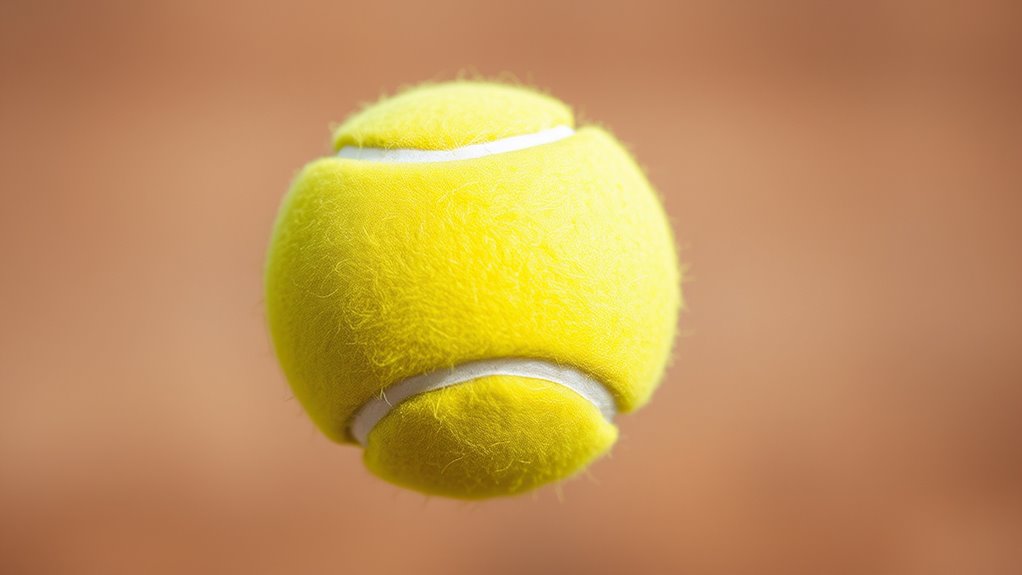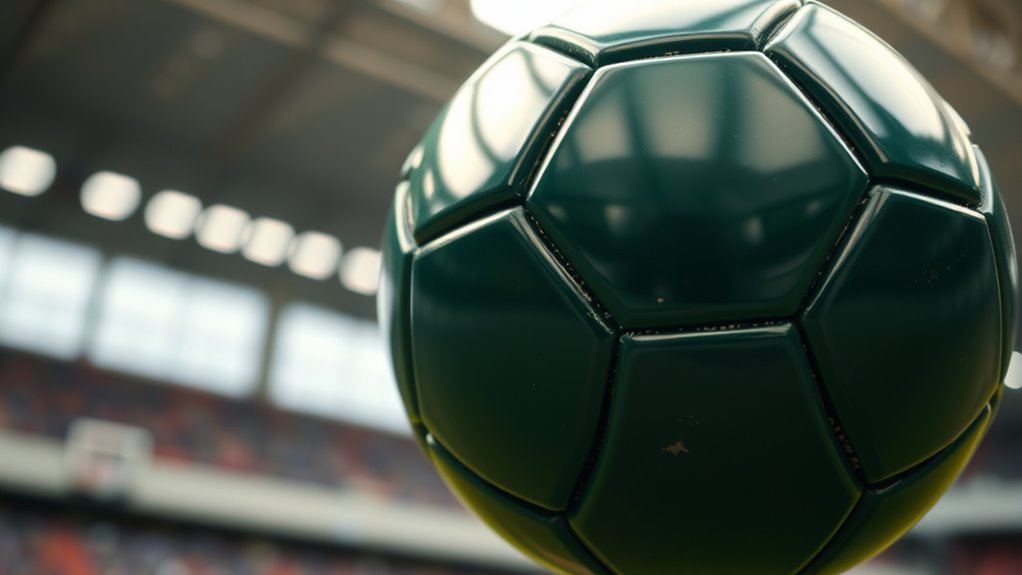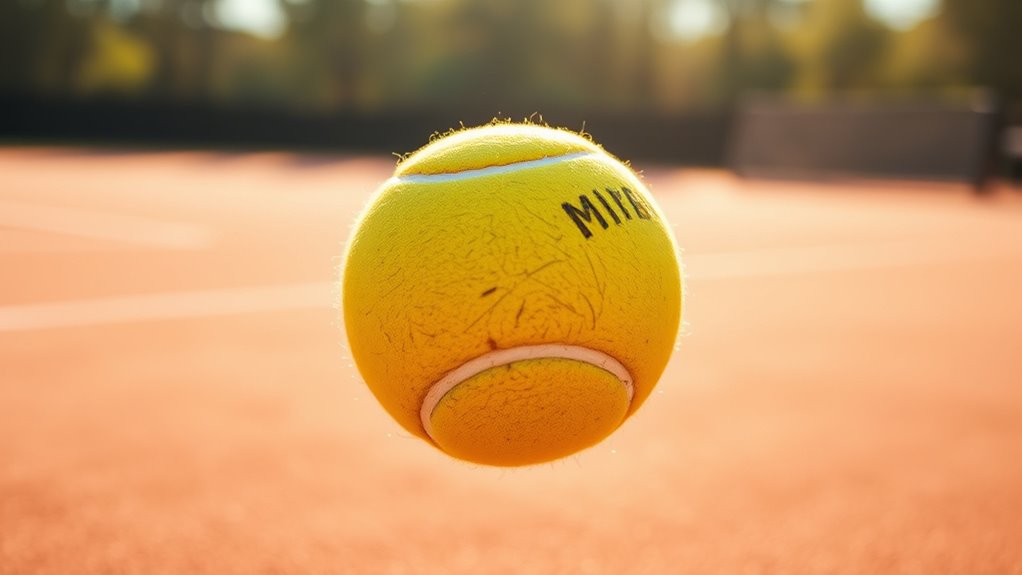Understanding the physics of ball spin and trajectory helps you control how the ball moves through the air. Spin affects lift and stability by creating pressure differences, thanks to the Magnus effect, causing the ball to curve or dip. Surface texture influences airflow and spin decay, impacting accuracy. By mastering these principles, you can predict and alter ball behavior more effectively—so, if you keep exploring, you’ll discover how physics can give you a real advantage on the field.
Key Takeaways
- Spin generates pressure differences via the Magnus effect, causing the ball to curve or dip during flight.
- Different spins (topspin, backspin, side spin) influence trajectory by altering lift, stability, and horizontal movement.
- Surface texture affects airflow separation, impacting spin decay, lift, and overall flight behavior.
- Air resistance and turbulence around the ball impact speed, stability, and the persistence of spin effects.
- Faster spin prolongs aerodynamic lift and curvature, while decay reduces the influence over time.
The Role of Spin in Ball Movement

Spin plays a essential role in how a ball moves through the air, directly affecting its trajectory and stability. As the ball spins, surface friction between it and the air creates forces that influence its path. Over time, spin decay occurs when the ball’s rotational speed decreases, reducing the effect of spin on its movement. This decay is primarily caused by surface friction, which slows the rotation as the ball interacts with the air and any contact surface. The faster the spin, the longer it maintains its influence before slowing down. Understanding how surface friction impacts spin decay helps you predict a ball’s behavior. Properly managing spin allows for better control and accuracy, especially in sports where ball trajectory is essential. Additionally, the principles of offensive security measures from ethical hacking can be metaphorically related to controlling and maintaining the ‘security’ of the ball’s movement during gameplay.
Aerodynamics and Air Resistance Effects

You’ll notice how airflow patterns around the ball influence its path, creating areas of turbulence and smooth flow. Drag and lift forces act on the ball, affecting speed and direction, especially when spin is involved. Understanding spin-induced air effects helps explain how these aerodynamic forces alter the ball’s trajectory in real time. Additionally, air resistance plays a crucial role in slowing down the ball and determining its overall flight behavior.
Airflow Patterns Around Ball
When a ball moves through the air, it creates complex airflow patterns around its surface that markedly influence its trajectory. The shape and texture of the ball surface determine how air flows over it, often leading to airflow turbulence. Smooth surfaces allow air to glide smoothly, reducing turbulence, while textured or rough surfaces disturb airflow, increasing turbulence. These turbulent airflow patterns can cause unpredictable shifts in the ball’s path, especially at higher speeds. As air moves past the ball, it forms vortices and eddies that vary depending on spin and velocity. Understanding these airflow patterns helps explain phenomena like swing and curve, as the turbulence affects how air pressure interacts with the ball, ultimately shaping its flight path. Additionally, air resistance plays a significant role in slowing the ball down and altering its trajectory over distance.
Drag and Lift Forces
As a ball moves through the air, it encounters forces that oppose its motion, primarily drag and lift. Drag depends on the ball surface and material properties; a smoother surface reduces air resistance, allowing for higher speeds. Rougher textures increase drag, slowing the ball down. Lift arises from differences in airflow around the ball, influenced by its shape and surface features. The material properties affect how air interacts with the ball, altering vortex formation and airflow separation points, which in turn impact lift. For example, a ball with a matte finish creates more turbulent airflow, increasing drag but potentially enhancing lift under certain conditions. Understanding these forces helps you predict how air resistance and the ball’s surface characteristics influence its trajectory and overall performance. Additionally, AI-powered content clusters can be used to analyze and optimize the factors affecting ball performance, leading to more precise predictions and improvements in design.
Spin-Induced Air Effects
Spin considerably influences a ball’s interaction with the surrounding air, generating aerodynamic effects that alter its trajectory and resistance. When you spin a ball, surface roughness plays a pivotal role—it affects how air flows over it, creating turbulence that influences lift and drag forces. A rougher surface increases airflow separation, which can lead to higher drag and faster spin decay. Conversely, a smoother surface promotes smoother airflow, reducing resistance and helping the ball maintain its spin longer. Spin-induced air effects can cause phenomena like the Magnus effect, bending the ball’s path. Additionally, surface texture significantly impacts airflow behavior around the ball, affecting its flight characteristics. Understanding these interactions helps you optimize spin techniques and equipment design, allowing for better control and predictability of the ball’s flight through the air.
The Magnus Effect and Its Impact

When you put spin on a ball, pressure differences develop on opposite sides, creating lift and affecting its path. This causes the ball’s trajectory to curve, often unexpectedly, due to the Magnus effect. Understanding these dynamics helps you predict and control ball movement more accurately. Additionally, the spin can influence the ball’s stability during flight, making it a critical factor in sports and other applications.
Spin-Induced Pressure Differences
The Magnus effect occurs because spinning objects create pressure differences in the surrounding air, influencing their trajectory. As you spin a ball, surface texture plays a role in how the air flows around it, affecting the pressure distribution. A smooth surface tends to produce a more predictable pressure difference, while rougher textures can enhance turbulence, altering the Magnus effect’s strength. Over time, spin decay reduces these pressure differences, diminishing the lift force that keeps the ball curving. This decay happens as the ball’s spin slows down due to air resistance and surface interactions. Understanding how surface texture impacts pressure differences helps you optimize spin and control, but keep in mind that as spin decreases, so does the influence of the Magnus effect on the ball’s flight. Additionally, the surface texture can influence the ball’s overall stability and consistency during flight.
Trajectory Curvature Dynamics
The Magnus effect directly influences a ball’s trajectory by generating lift that causes it to curve during flight. When you spin a ball, the interaction between its surface and the air creates pressure differences that lead to this lift. The amount of curvature depends on the ball material; a smoother surface reduces friction, lessening the effect, while textured surfaces boost it. Environmental conditions also play a role—wind, humidity, and air density can amplify or diminish the ball’s curvature. A heavier or denser ball responds differently to spin compared to a lighter one, affecting how sharply it curves. The surface texture of the ball significantly impacts the magnitude of the Magnus effect, with rougher surfaces increasing lift and curvature. Understanding these factors helps you predict and control trajectory changes during play, as the combination of ball material and environmental conditions determines the extent of the Magnus effect’s impact on your shot.
Aerodynamic Lift Effects
Ever wonder how a spinning ball curves midair? That’s the aerodynamic lift effect, driven by the Magnus effect. When you spin a ball, the surface interacts with the air differently on each side. The spin rate affects how much lift is generated: the faster the spin, the greater the lift force. As the ball moves, air flows faster over one side of the ball surface and slower on the other. This creates a pressure difference, pushing the ball in the direction of the spin. The result is a curved trajectory rather than a straight path. Your control of spin rate and surface texture directly influences this lift effect, allowing skilled players to manipulate ball movement precisely. Additionally, understanding the regional legal resources can help in cases where sports regulations or disputes are involved. It’s a fascinating interplay of physics and technique.
Types of Spin and Their Influence on Trajectory

Different types of spin dramatically affect a ball’s trajectory, shaping how it moves through the air. Topspin causes the ball to dip faster because surface friction increases as the ball moves forward, creating a downward force. Backspin generates lift, making the ball stay in the air longer and travel farther by creating a cushion of air beneath it. Side spin, such as sidespin, curves the ball’s path horizontally due to asymmetric surface friction, resulting in a curved trajectory. Spin decay also influences these effects; as the ball spins less over time, its trajectory becomes less predictable. The amount of surface friction between the ball and the air determines how quickly spin decreases, impacting the ball’s stability and movement during flight. Understanding how these spins interact with the aerodynamics of balls helps players optimize their shots and anticipate ball behavior.
Physics Behind Ball Stability and Unpredictable Movements

Understanding what keeps a ball stable during flight involves examining how spin, air currents, and surface interactions work together. The ball’s mass influences its inertia, helping it resist sudden changes in direction, which contributes to stability. Surface texture plays a vital role; a smooth surface reduces air turbulence, while a rougher surface can cause unpredictable air flow, leading to erratic movements. When a ball spins, the Magnus effect interacts with airflow patterns, either stabilizing or destabilizing its path depending on surface conditions. Unpredictable movements often occur when small variations in surface texture or shifts in air currents disrupt the balance of forces acting on the ball. These complex interactions explain why some shots curve unexpectedly or wobble mid-flight.
Practical Applications and Strategies in Sports

Athletes and coaches leverage the physics of ball spin and trajectory to improve performance and control. Understanding how ball bounce is affected by spin and material elasticity helps players predict ball behavior more accurately. For example, a tennis player can apply topspin to increase ball bounce, making it harder for opponents to return. In basketball, knowing how the ball’s elasticity influences rebound guides shooting techniques. Coaches teach players to adjust their strikes based on the ball’s material properties, optimizing spin and trajectory. Recognizing how different surfaces and ball conditions affect bounce enables better strategy. By mastering these principles, you can manipulate the ball’s behavior intentionally, gaining a competitive edge. Ultimately, applying physics knowledge enhances precision, consistency, and successful execution across various sports.
Frequently Asked Questions
How Does Humidity Affect Ball Spin and Flight?
Humidity impact can considerably influence your ball flight. When humidity is high, the air becomes more humid, which can make the ball’s spin less effective and slightly reduce its distance. You might notice the ball doesn’t carry as far or stay as stable in flight. This is because moist air creates more drag, slowing the ball down and affecting its overall trajectory during play.
What Materials Optimize Spin Control in Sports Balls?
Imagine you’re back in Victorian England, discovering new sports. To optimize spin control, you should choose materials with ideal surface textures and appropriate material densities. Rubber with textured surfaces, for example, enhances grip and spin, while denser materials provide better stability. These factors help you fine-tune ball behavior, giving you more control during play. Selecting the right combination of surface texture and density makes a noticeable difference in your game.
Can Environmental Factors Override Spin Effects?
Environmental factors like atmospheric pressure and surface roughness can influence ball behavior, but they don’t override spin effects entirely. You’ll find that lower atmospheric pressure can reduce air resistance, while rougher surfaces may increase friction, affecting spin. However, your initial spin still plays a significant role in the ball’s path. So, while environmental factors matter, they usually modify rather than completely override the effects of spin on the ball’s trajectory.
How Do Different Ball Sizes Influence Trajectory Predictions?
When considering how different ball sizes influence trajectory prediction, you need to realize that larger balls generally experience more air resistance, which can alter their path. Smaller balls tend to be more affected by spin and environmental factors, making predictions trickier. By accounting for ball size, you improve your accuracy in trajectory prediction, ensuring you adjust your technique based on the ball’s dimensions to better anticipate its flight path.
What Role Does Player Technique Play in Spin Accuracy?
Imagine your technique as the compass guiding your spin accuracy. You play a vital role through your grip consistency and wrist flexibility, which directly influence the ball’s spin. When you maintain a steady grip and stay flexible in your wrist, you create more controlled, precise spins. Your technique becomes the brushstroke shaping the ball’s trajectory, turning skill into an art that determines your success on every shot.
Conclusion
Understanding the physics of ball spin and trajectory is like mastering a secret code in sports. When you realize how a well-placed spin can curve a ball just like a river bends around rocks, you discover new strategies to outsmart opponents. Imagine a soccer player’s precise flick causing the ball to dip unexpectedly—it’s all about physics in action. By applying these principles, you can improve your game and surprise everyone with your skill and control.









